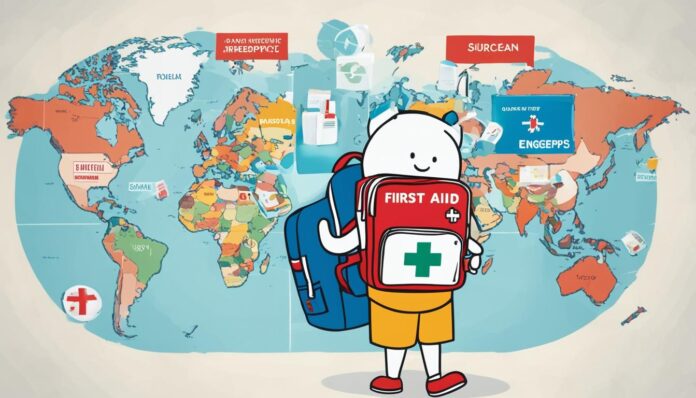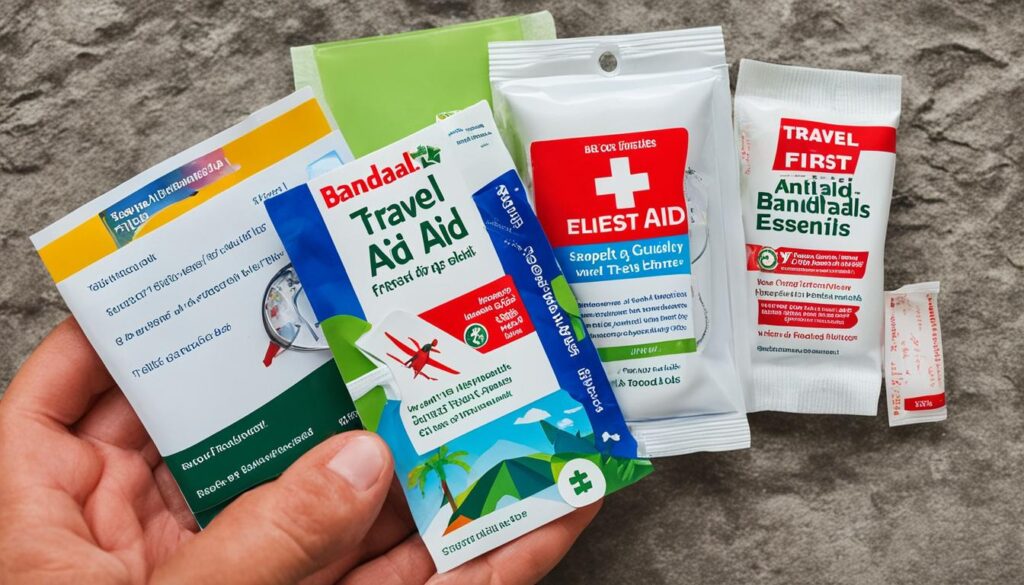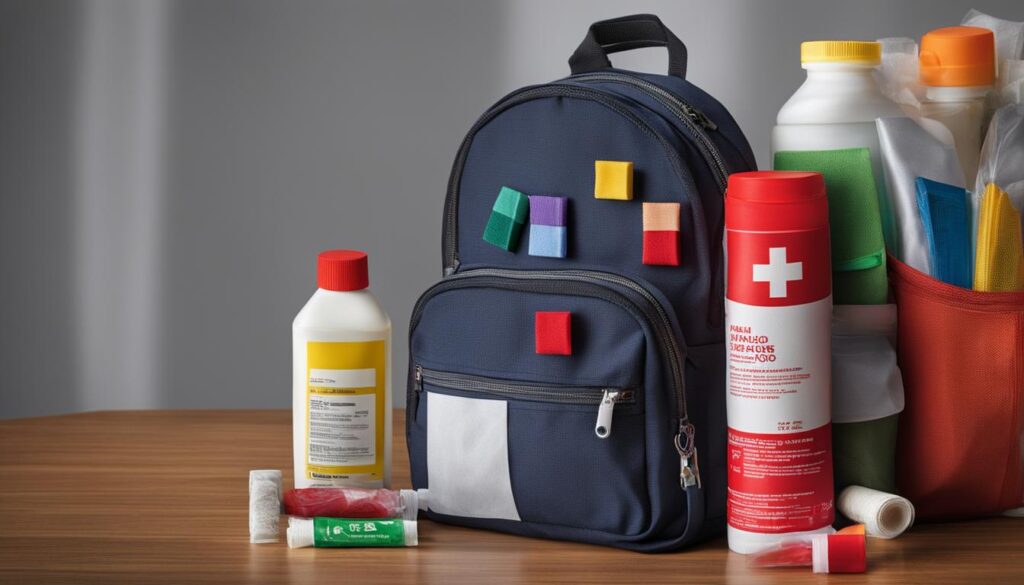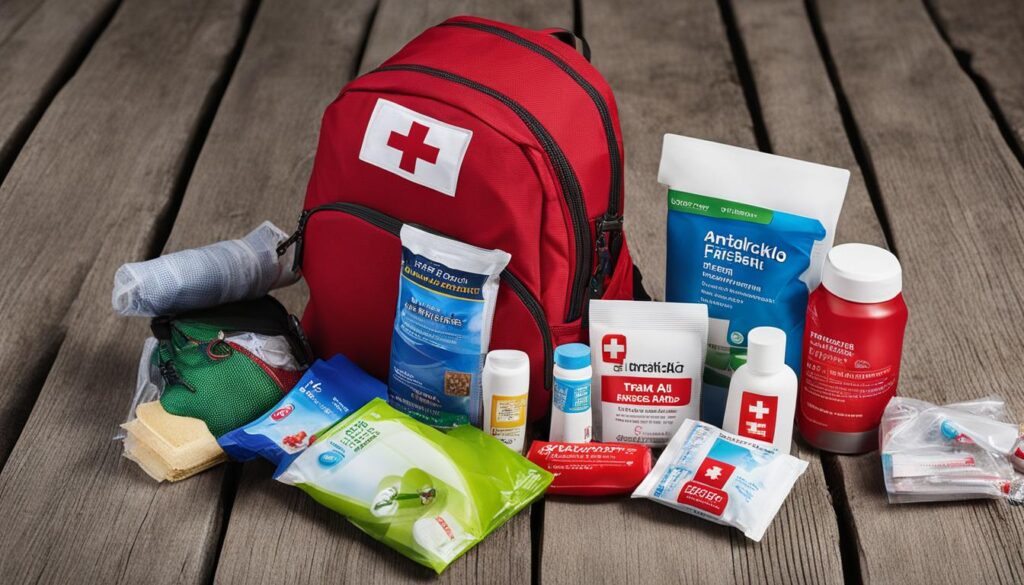Are you planning a family vacation soon? Packing the essential items for your trip is crucial to ensure everyone’s safety and well-being. When traveling with kids, it’s essential to be prepared for any medical emergencies that may arise. That’s why packing a kids travel first aid kit should be a top priority.
Having a comprehensive travel first aid kit for your children can help you manage unexpected situations and avoid turning a minor injury or illness into a major issue.
In this section, we will cover everything you need to know about travel first aid for kids. You’ll learn the importance of having a designated first aid kit for children and the must-have items to include in it. By the end of this section, you’ll be better prepared to handle any medical situation that comes your way during family vacations.
The Importance of Travel First Aid for Kids
Traveling with kids can be a wonderful experience, but it also presents unique challenges and risks. Whether you’re embarking on a road trip, flying across the country, or exploring a new country, it’s essential to be prepared for any medical emergencies that may arise. That’s why travel first aid essentials for children should always be a top priority for parents and caregivers.
Children have a higher risk of accidents and illnesses while traveling than adults do. The unfamiliar environments, new foods, and climate changes can all affect their health. Having child-friendly travel first aid supplies can make a huge difference in treating injuries and illnesses promptly and effectively.
When selecting travel first aid supplies for children, consider their unique needs and vulnerabilities. Children have different medical requirements than adults and may require specialized items in their first aid kit. For instance, children are more prone to dehydration, so it’s important to have oral rehydration fluids, such as Pedialyte, packed in their travel first aid kit.
Other must-have travel first aid supplies for kids include:
| Item | Purpose |
|---|---|
| Adhesive bandages | To cover and protect minor cuts and scrapes |
| Antiseptic wipes and sprays | To clean and disinfect wounds and cuts |
| Instant cold packs | To relieve swelling and inflammation of minor injuries |
| Thermometer | To assess if a child has a fever |
| Tweezers | To remove splinters and ticks from the skin |
| Any specific prescription medication for your child | To manage pre-existing medical conditions or allergies |
Travel first aid essentials for children come in different shapes, sizes, and brands, so it’s important to do your research and opt for products that meet your specific needs. Look for child-friendly travel first aid supplies explicitly tailored to children, including age-appropriate dosages, flavors, and packaging.
By being prepared and packing child-friendly travel first aid supplies in advance, you can rest assured that you’re providing the best possible care for your child while on vacation. Now that we’ve covered the importance of travel first aid for kids, let’s delve deeper into the guide on building a comprehensive travel first aid kit for kids.
Building a Travel First Aid Kit for Kids
When it comes to travel, it’s always better to be safe than sorry, especially when it comes to first aid. Building a travel first aid kit for kids is an essential step in ensuring their safety and well-being during family vacations. Here’s a checklist of some of the must-have items to include:
| Item | Quantity |
|---|---|
| Adhesive bandages | Assorted sizes |
| Antiseptic wipes | 1 box |
| Gauze pads | Assorted sizes |
| Tweezers | 1 pair |
| Scissors | 1 pair |
| Thermometer | 1 digital |
| Sunscreen | 1 bottle |
| Insect repellant | 1 bottle |
| Medications | As needed |
| Emergency phone numbers | 1 list |
| Medical consent form | 1 copy |
These items are just the basics, and you may want to include additional items based on your destination, itinerary, and your child’s specific needs. It’s always better to be over-prepared than under-prepared.
When packing your travel first aid kit, it’s important to keep everything organized and easily accessible. Consider using a waterproof, durable container that can fit in your luggage. You may also want to pack a smaller, portable kit to take with you on day trips and excursions.
Remember to regularly check and restock your travel first aid kit, so you’re prepared for future travels. A well-stocked and organized kit can help you feel more confident and prepared to handle any minor injuries or illnesses that may arise during your family vacation.
Essential First Aid Supplies for Family Travel
When traveling with children, it’s essential to have a well-stocked first aid kit to address any unexpected emergencies or common ailments. Here are the best first aid items for traveling with children that you should include in your first aid checklist for kids on vacation:
| First Aid Item | Purpose |
|---|---|
| Bandages and adhesive tape | To secure a small cut or wound. |
| Antiseptic wipes and ointment | To clean wounds and prevent infection. |
| Pain relievers and fever reducers | To alleviate headaches, fever, or pain from minor injuries. |
| Thermometer | To monitor your child’s temperature in case of fever. |
| Tweezers | To remove splinters or insect stings. |
| Sunscreen and insect repellent | To protect your child from the sun’s rays and insect bites. |
| Disposable gloves | To minimize the risk of infection when providing first aid. |
| Instant cold pack | To reduce swelling and ease pain from minor injuries. |
| Saline solution | To rinse dirt or debris from your child’s eyes or wounds. |
| Medications | If your child requires any specific medication, ensure that you have enough for the duration of your trip. |
Make sure to store these essential first aid supplies in a well-organized, easy-to-access manner in your travel first aid kit for kids. This will make it easier to quickly respond to any emergencies while on vacation.
Remember, having a well-stocked, child-friendly travel first aid kit is crucial for ensuring your family’s safety and well-being while on vacation.
Dealing with Common Travel-Related Ailments
Traveling with kids is not just about exploring new destinations; it also involves facing common ailments that may affect their health while on the road. As a parent, you must know how to handle these issues and be prepared with the right travel first aid items for your children.
Motion Sickness
Motion sickness is common in children, especially during car trips, airplane rides, or boat tours. It is caused by the brain receiving mixed signals from the inner ear, eyes, and other sensory organs. Symptoms include nausea, vomiting, headache, and fatigue.
To prevent motion sickness, encourage your child to look out the window, take slow, deep breaths, and sip water frequently. You can also try over-the-counter remedies, such as antihistamines or ginger supplements, that are safe for children. Make sure to pack these items in your kids’ travel first aid kit.
Allergies
Travel exposes your child to new allergens that may trigger allergic reactions. Common allergens include pollen, dust mites, animal fur, certain foods, insect venom, and latex. Symptoms range from mild rashes or itchiness to life-threatening anaphylaxis, which requires immediate medical intervention.
If your child has known allergies, make sure to carry their allergy medications, such as antihistamines, epinephrine auto-injectors, and inhalers, in your travel first aid kit. Also, research your destination’s local allergens and take precautionary measures, such as avoiding certain foods or booking allergy-friendly accommodations.
| Travel First Aid Items for Allergies | Symptoms to Watch Out for |
|---|---|
| Allergy medications | Rashes, hives, swelling, difficulty breathing, anaphylaxis |
| Medical alert bracelet | Emergency responders can quickly identify your child’s allergies and provide appropriate care |
| Tick removal tool | Removes ticks that may cause Lyme disease or other tick-borne illnesses |
| Portable air purifier | Reduces exposure to airborne allergens in hotel rooms or rental apartments |
Insect Bites
Insect bites and stings can be painful and cause redness, swelling, and itching. Some insects, such as mosquitos and ticks, may also transmit diseases like malaria, dengue fever, or Lyme disease.
To prevent insect bites, use insect repellents with DEET or picaridin, dress in long-sleeved shirts and pants, and avoid outdoor activities during dawn and dusk when mosquitos are most active. If your child does get bitten, use antihistamines, calamine lotion, or cold compresses to relieve the symptoms. Also, pack a tick removal tool in your travel first aid kit to prevent tick-borne diseases.
By being aware of common travel-related ailments and packing the essential travel first aid items for your kids, you can handle any health issue that may arise during your family trip. Remember to consult with your child’s pediatrician before traveling, especially if they have any chronic medical conditions or are taking prescription medications.
Safety Tips for Outdoor Adventures
Exploring nature during family vacations can be an exciting experience for kids. However, it’s essential to take necessary precautions to stay safe and avoid injuries. Here are some safety tips for outdoor activities during family travel:
- Always supervise your children during outdoor play to prevent accidents.
- Dress your child appropriately for the activity and weather conditions. Pack rain gear, warm clothing, and comfortable shoes or hiking boots.
- Apply sunscreen and insect repellent to protect your child from sunburn and insect bites.
- Stay hydrated by bringing a sufficient amount of water for the whole family.
- Research the area before heading out to ensure there are no potential safety hazards.
- Carry a map and a compass or GPS device to avoid getting lost.
- Pack a whistle, flashlight, and extra batteries in case of emergencies.
Accidents can happen, even when you take appropriate safety measures. Be prepared for common injuries and emergencies by packing a travel first aid kit for kids that includes the following:
| Top Travel First Aid Products for Kids | Description |
|---|---|
| Band-Aids | A variety of sizes and shapes to cover cuts and scrapes. |
| Gauze pads and medical tape | For larger wounds and injuries. |
| Antibiotic ointment | To prevent infection. |
| Hydrocortisone cream | For insect bites and allergic rashes. |
| Insect repellent wipes/spray | To prevent mosquito bites and other insect-related issues. |
| Tweezers | For removing splinters or ticks. |
| Pain reliever/fever reducer | To alleviate pain and fever. |
| Saline solution | To clean wounds and irritations. |
Remember, prevention is always the best strategy. Following these safety tips and packing essential travel first aid supplies for kids can help ensure a safe and enjoyable outdoor adventure with your family.
First Aid for Minor Injuries
While traveling, kids tend to explore new places and may face minor injuries like cuts, scrapes, bruises, or burns. These injuries may seem small, but it’s important to take the necessary precautions to prevent further complications.
The first step is to ensure that your travel first aid kit for kids has all the travel first aid essentials for children. A well-stocked kit will have bandages, antiseptic wipes, gauze, scissors, tweezers, and medical tape. When packing, make sure to store the supplies carefully to avoid any spills or tears.
If your child gets a minor cut or scrape, first wash the wound with mild soap and water. Then apply antiseptic topically before covering the area with a sterile bandage. This will help prevent infection and promote healing. For burns, use cool water or a cold compress to soothe the area and cover with a loose bandage if necessary.
For first aid checklist for kids on vacation, refer to the following table:
Cut and Scrape Care Best Practices
When caring for a cut or scrape, follow these best practices to avoid worsening the injury:
- Clean the wound with soap and water before applying ointment.
- Cover the wound with a sterile dressing to prevent infection.
- Change the dressing regularly to keep the wound clean and dry.
- Watch for signs of an infection, such as redness or pus.
Burn Care Best Practices
Follow these best practices when caring for a burn:
- If a burn is severe or covers a large area, seek medical attention immediately.
- For minor burns, cool the affected area with cold water or a cool, wet compress.
- Use a sterile, non-adhesive dressing like gauze to cover the burn.
- Do not pop or pick any blisters that form from a burn – this can lead to infection.
“Don’t neglect minor injuries; proper care can prevent complications and ensure that your child enjoys the rest of their vacation.”
Managing Allergic Reactions
Allergic reactions can be alarming, especially when far from home, so it pays to be prepared with child-friendly travel first aid supplies. There are a few types of allergies that your child may encounter while traveling, and each requires a specific set of must-have first aid supplies for family travel.
| Allergy Type | Essentials First Aid Supplies |
|---|---|
| Food Allergy |
|
| Insect Allergy |
|
| Environmental Allergy |
|
It’s crucial to keep these items organized in a designated section of your kids’ travel first aid kit, labeled for easy access. Additionally, remember to inform your child’s travel companions and trip leaders of specific allergy precautions and the location of the first aid kits.
Tip: Also, make sure to research the nearest medical facilities and hospitals in the area, in case of a severe allergic reaction.
Handling Travel Emergencies
When traveling with kids, it’s always better to be safe than sorry. Emergencies can happen anytime, anywhere, and knowing how to handle them can make all the difference. In this section, we’ll provide you with essential first aid tips for traveling with kids, along with the best first aid items you should always pack in your travel first aid kit.
Identifying Travel Emergencies
The first step to handling travel emergencies is to identify them quickly. Keep an eye out for signs of allergies, such as hives, swelling, or difficulty breathing. Look for wounds, cuts, or bruises that may need immediate attention. Symptomatic complaints like fever, abdominal pain, or headaches may also indicate an emergency.
It’s also important to know the location of the nearest hospital or medical center in case of a medical emergency.
Essential First Aid Tips for Traveling with Kids
Here are some essential first aid tips to keep in mind when traveling with kids:
- Pack a travel first aid kit. Make sure you have all the essential first aid items for traveling with children, such as adhesive bandages, gauze, antiseptic wipes, and pain relievers.
- Stay calm and reassure your child. In case of an emergency, it’s essential to stay calm and reassure your child to avoid anxiety or panic.
- Follow proper first aid procedures. Administer the proper first aid procedure for the emergency.
- Monitor your child’s condition. After administering first aid, continue to monitor your child’s condition and seek medical attention if necessary.
Best First Aid Items for Traveling with Children
Here are the best first aid items to pack in your travel first aid kit when traveling with kids:
| First Aid Item | Purpose |
|---|---|
| Adhesive bandages | To cover wounds, cuts, and scrapes. |
| Gauze | To protect wounds and stop bleeding. |
| Antiseptic wipes | To clean wounds and prevent infection. |
| Pain relievers | To alleviate pain and fever. |
| Thermometer | To monitor your child’s temperature. |
| Tweezers | To remove splinters or ticks. |
| Hydrocortisone cream | To relieve itching and inflammation caused by insect bites, poison ivy, or eczema. |
| Epinephrine autoinjector | To treat severe allergic reactions. |
Remember, handling travel emergencies can be stressful, but by staying prepared with essential first aid tips and the right first aid items, you can ensure the safety of your child while traveling.
Tips for Administering First Aid to Kids
Administering first aid to children can be a daunting task, especially when in an unfamiliar setting. However, quick and effective response can help prevent the situation from escalating. Below are some useful tips and techniques for providing travel first aid for kids:
- Stay calm: Children can become more distressed if their caregiver is agitated. Try to remain calm and in control of the situation. Speak in a reassuring tone and let the child know that you are here to help.
- Provide comfort: Hold the child’s hand or give them a gentle hug to provide comfort and reassurance.
- Understand pediatric dosages: If administering medication, ensure that you understand the safe and appropriate dosage for the child’s age and weight.
- Follow basic first aid steps: Clean the wound and cover it with a sterile bandage, apply pressure to stop bleeding, and immobilize the affected area if necessary.
- Seek professional help if needed: If the child’s condition is severe, or you are unsure of how to proceed, seek professional help immediately. You can call local emergency services or visit the nearest hospital or clinic.
Remember that children’s first aid needs can vary based on their age, development, and prior medical history. Always prepare a kids travel first aid kit and review its contents regularly to ensure you have the necessary supplies for any trip.
“Administering first aid to kids can be challenging, but practicing these tips will help you stay prepared and keep your child safe during family travels.”
Emergency Contacts and Medical Information
When it comes to travel first aid for kids, having quick access to emergency contacts and relevant medical information is crucial. You never know when you might need to provide this information in an emergency situation. Make sure to carry essential documents with you, such as emergency contact numbers, insurance information, and your child’s medical history.
It’s also important to organize and store this information effectively. Consider creating a simple document or spreadsheet with important details and keeping a physical copy with your travel first aid kit.
Essential Information to Include
Here are some essential pieces of information to include:
- Your child’s full name, date of birth, and allergies
- Your pediatrician’s name and phone number
- Your insurance company’s name, policy number, and emergency contact number
- Emergency contact information for family members or friends
- Any medical conditions or medications your child is taking
Storing Your Information
There are several ways to store your emergency contacts and medical information, including:
- Creating a document or spreadsheet and saving it on your phone or laptop
- Downloading a travel safety app that allows you to store this information
- Keeping a physical copy in your travel first aid kit
Conclusion
When it comes to family travel, ensuring your child’s safety should be a top priority. A comprehensive travel first aid kit tailored to your child’s needs is an essential item to bring on any trip. By following our tips and recommendations, you can build a reliable kit that can handle common ailments, minor injuries, and emergencies that may arise during your journey. Remember to check and restock your kit regularly to stay prepared for future travels.
Furthermore, being knowledgeable about administering first aid to your child and carrying essential documents such as emergency contacts and medical information can provide you with peace of mind. You can rest easy knowing that you’re prepared for any situation that may come your way.
We hope that our guide has been helpful in preparing you for your next family adventure. Have a great trip!
















































